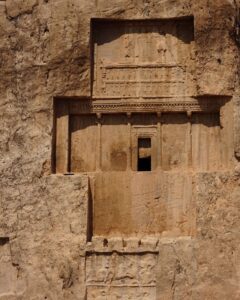Introduction
Naqsh-e Rostam, a site of immense historical significance located in Iran, houses the tomb of Darius I, one of the most illustrious kings of the Achaemenid Empire. This site not only reflects the grandeur of ancient Persian architecture but also serves as a testament to the artistic achievements of subsequent Persian dynasties, particularly the Sasanian period. In close proximity to Darius I’s tomb lies an impressive equestrian relief of Bahram II, a Sasanian king, which further enriches the historical narrative of this remarkable site.

The Tomb of Darius I
Architectural Marvel
The tomb of Darius I, dated approximately between 522 and 486 BC, is carved into the rock face at a considerable height, making it a striking feature against the natural landscape. The choice of elevation for the tomb symbolizes the king’s divine status and his connection to the heavens. This architectural marvel showcases the advanced engineering techniques of the Achaemenid era, employing intricate carvings that depict not only Darius I but also motifs reflecting the empire’s grandeur.
Cultural Significance
Darius I, known for his administrative innovations and extensive building projects, expanded the Achaemenid Empire to its greatest territorial extent. His tomb is a reflection of his legacy, embodying the political and cultural aspirations of a dynasty that emphasized the importance of divine kingship. The carvings around the tomb often depict scenes of royal power and divine favor, reinforcing the notion of the king as a mediator between the gods and his people.

The Equestrian Relief of Bahram II
Artistic Excellence
Situated immediately below Darius I’s tomb is the striking equestrian relief of Bahram II, who ruled during the Sasanian period from approximately 276 to 293 AD. This relief, which features the king on horseback, is significant for its detailed representation of royal iconography. The inclusion of human figures for scale not only enhances the grandeur of the depiction but also allows us to appreciate the intricacy and scale of Sasanian art.
Historical Context
The Sasanian Empire, which succeeded the Achaemenid dynasty, continued the tradition of monumental art and architecture, albeit with its unique style and thematic focus. Bahram II’s relief serves as an example of how the Sasanians drew upon and transformed earlier Persian artistic traditions. The portrayal of the king in an equestrian posture conveys themes of valor, strength, and sovereignty, attributes highly esteemed in Sasanian culture.
Conclusion
The juxtaposition of the tomb of Darius I and the equestrian relief of Bahram II at Naqsh-e Rostam serves as a profound illustration of the continuity and evolution of Persian royal iconography. These monuments not only highlight the architectural and artistic achievements of their respective eras but also reflect the enduring legacy of the Persian empires. As we study these remarkable works, we gain deeper insights into the cultural, political, and spiritual dimensions of ancient Persia, which continue to resonate through history.
